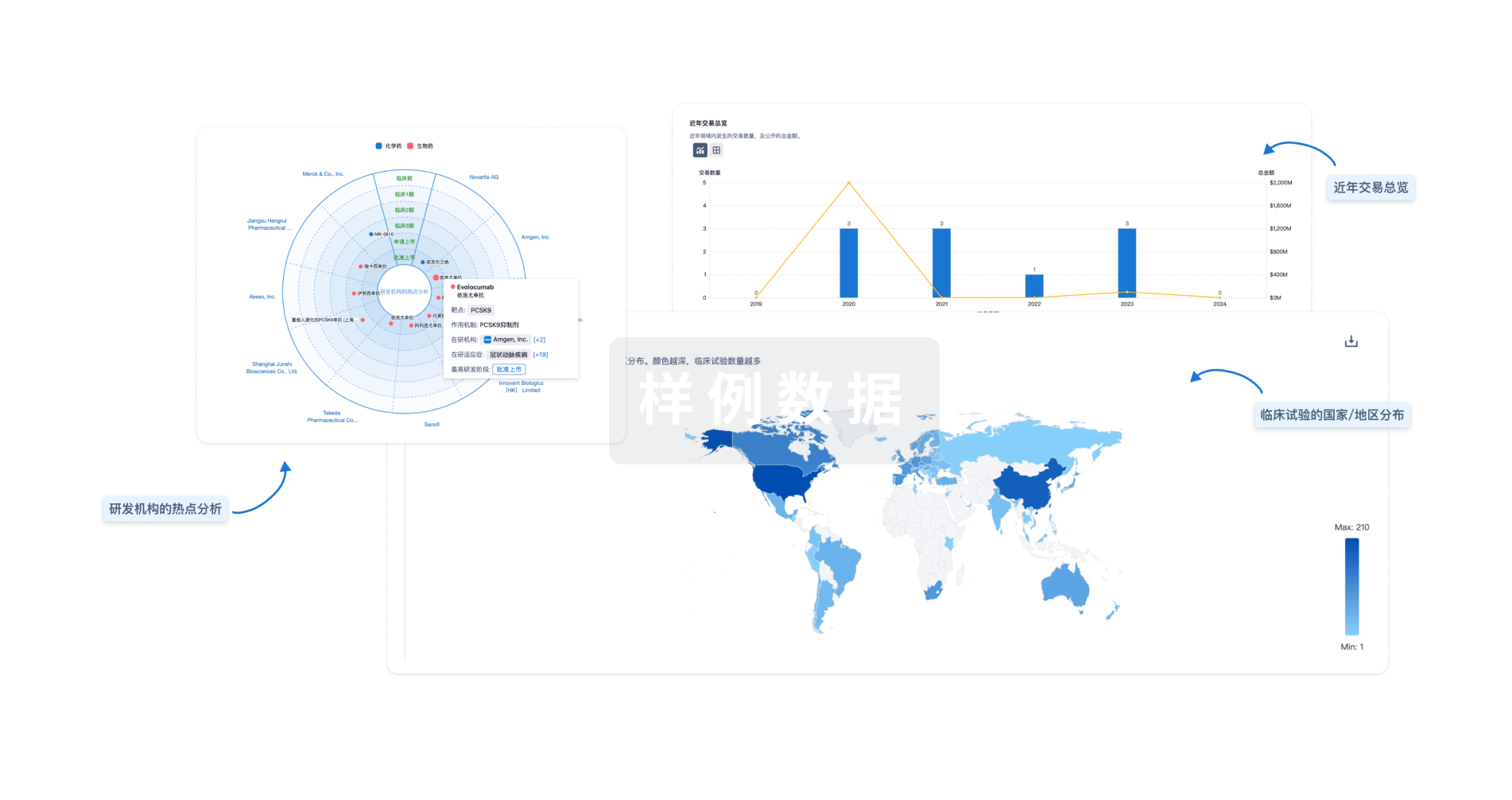预约演示
更新于:2025-05-07
CLDN18.2 x PDL1
更新于:2025-05-07
关联
6
项与 CLDN18.2 x PDL1 相关的药物作用机制 CLDN18.2抑制剂 [+1] |
在研机构 |
原研机构 |
在研适应症 |
非在研适应症- |
最高研发阶段临床1/2期 |
首次获批国家/地区- |
首次获批日期1800-01-20 |
作用机制 CLDN18.2抑制剂 [+1] |
非在研适应症- |
最高研发阶段临床前 |
首次获批国家/地区- |
首次获批日期1800-01-20 |
5
项与 CLDN18.2 x PDL1 相关的临床试验NCT06084286
A Phase I, Open-label, Single-arm, Dose-escalation and Expansion Study of Specific Dual-targeting CLDN18.2 and PD-L1 CAR-T for Patients with CLDN18.2-positive Advanced Solid Tumors
Claudin18.2(CLDN18.2) is a kind of integrin membrane protein in the tight junction between epithelium and endothelium, which is highly expressed in many solid tumors, especially in gastric cancer and pancreatic cancer. The CLDN18.2/PD-L1 dual-targeting CAR-T will be investigated in patients with CLDN18.2-positive advance solid tumors.
开始日期2024-01-01 |
申办/合作机构 |
NCT05964543
A Phase I/II Clinical Trial to Evaluate the Safety Tolerance and Initial Efficacy of Q-1802 Combined With Standard Treatment in Patients With Gastrointestinal Tumors
The main purpose of this study is to evaluate safety, tolerability and the efficacy of Q-1802 plus SOC compared with SOC. .Pharmacokinetics (PK) ,Pharmacodynamics (PD) of Q-1802 and the immunogenicity profile of Q-1802 will be evaluated as well.
开始日期2023-06-21 |
申办/合作机构 |
100 项与 CLDN18.2 x PDL1 相关的临床结果
登录后查看更多信息
100 项与 CLDN18.2 x PDL1 相关的转化医学
登录后查看更多信息
0 项与 CLDN18.2 x PDL1 相关的专利(医药)
登录后查看更多信息
46
项与 CLDN18.2 x PDL1 相关的文献(医药)2025-04-01·Advanced Science
A CLDN18.2‐Targeted Nanoplatform Manipulates Magnetic Hyperthermia Spatiotemporally for Synergistic Immunotherapy in Gastric Cancer
Article
作者: Guo, Xiaoyong ; Ji, Jiafu ; Chen, Cong ; Han, Jing ; Du, Yang ; Du, Hong ; Wang, Xueying ; Tian, Jie ; Wang, Yiding ; Guo, Ting ; Xing, Xiaofang ; He, Jie ; Hui, Hui ; Zhong, Fuyu ; Meng, Lin
2025-03-04·Expert Review of Anticancer Therapy
Contemporary management of advanced gastric and gastroesophageal adenocarcinomas
Review
作者: Rogers, Jane E. ; Ajani, Jaffer A.
2025-03-01·Applied Immunohistochemistry & Molecular Morphology
Claudin 18.2 Immunohistochemistry Expression in Gastric Cancer: A Systematic Review
Review
作者: Santiago Díaz, Pablo ; Lop Gros, Joan ; Larrubia Loring, Mónica ; Lloveras, Belen ; Iglesias, Mar ; Patriarca, Maria E.
877
项与 CLDN18.2 x PDL1 相关的新闻(医药)2025-05-01
·药智网
在癌症的众多类型中,胰腺癌因其极高的恶性程度和治疗难度,被称为“癌王”。国家癌症中心数据显示,2023年全球胰腺癌新发62万例,中国占比20%,同时,胰腺癌的死亡率也非常惊人。中国患者5年生存率仅7.2%,与结直肠癌64%的5年生存率相比,简直是天壤之别。对于胰腺癌患者来说,可手术患者中位OS(总生存期)为22个月,而转移性患者中位OS仅6个月。如此悬殊的预后差异,让胰腺癌成为当之无愧的“生命杀手”。面对胰腺癌这一严峻的挑战,康方生物推出了AK132双抗这一有望攻克“癌王”的重磅产品。AK132作为一种可以同时阻断CLDN18.2和CD47的双特异性抗体,为胰腺癌治疗带来了新的希望。1巨大挑战面对胰腺癌这一强大的敌人,现有的治疗手段显得有些力不从心。化疗作为胰腺癌治疗的重要手段之一,虽然在一定程度上能够延长患者的生存期,但也面临着天花板。改良FOLFIRINOX方案是目前常用的化疗方案之一,其ORR(客观缓解率)为31.6%,但3级AE(不良事件)高达85%。而免疫治疗在胰腺癌的治疗中,更是遭遇了滑铁卢。胰腺癌的微环境就像一个坚固的物理屏障,α-SMA+CAF(α-平滑肌肌动蛋白阳性的癌相关成纤维细胞)占比>50%,使得免疫细胞难以进入肿瘤内部发挥作用。同时,胰腺癌还具有免疫“冷肿瘤”特征,CD8+T细胞浸润<5%,这使得免疫治疗难以激活机体的免疫反应,从而对肿瘤细胞进行有效杀伤。免疫治疗在胰腺癌领域的失败,充分证明了胰腺癌微环境的特殊性和复杂性。想要攻克胰腺癌,必须针对其独特的肿瘤微环境和免疫特征进行研发,而双抗药物或许能打破这一僵局。在寻找攻克胰腺癌的道路上,靶点开发也是困难重重。以EGFR抑制剂厄洛替尼为例,虽然它被用于胰腺癌的治疗,但临床研究表明,其OS仅延长12天,几乎可以忽略不计。不过,在黑暗中也总有一丝曙光。Claudin18.2和TGF-β等靶点,为胰腺癌的治疗带来了新的希望。Claudin18.2在胰腺癌中的表达率为58%,这意味着超过一半的胰腺癌患者可能适合以Claudin18.2为靶点的治疗。而TGF-β虽然目前还处于临床前研究阶段,但已有协同证据表明,它可能在胰腺癌的治疗中发挥重要作用。胰腺癌的治疗现状不容乐观,无论是流行病学数据、现有治疗手段,还是靶点开发,都面临着巨大的挑战。在这样的背景下,康方生物的AK132作为一款Claudin18.2/PD-L1双抗,能否成为攻克胰腺癌这座“肿瘤堡垒”的关键武器?2科学突破在2024年肿瘤免疫治疗学会年会上,康方生物首次对外发布了其自主研发的双特异性抗体新药Claudin18.2(CLDN18.2)/CD47双特异性抗体AK132的药物机制研究成果。AK132是一种“1+1”价态的不对称双特异性抗体,可同时靶向和阻断CLDN18.2和CD47,并具有野生型IgG1 Fc结构AK132能够拥有如此出色的性能,离不开康方生物自主开发的Tetrabody平台。该平台赋予了AK132诸多差异化优势,使其在同类竞品中脱颖而出。从亲和力和半衰期等参数对比来看,康方AK132展现出了独特的技术优势。AK132的亲和力(nM)为0.32,相比QLS31905的1.05和安进AMG910的0.68,具有更高的亲和力,它能够更紧密地与靶点结合,从而更有效地发挥作用。在半衰期(h)方面,AK132达到了216,高于QLS31905的189和安进AMG910的156。较长的半衰期使得AK132在体内能够维持更稳定的药物浓度,减少给药频率,提高患者的依从性。图1 AK132结合于CHO-K1-CLDN18.2/CD47细胞图片来源:参考文献1Tetrabody平台还克服了双抗开发过程中的诸多难题,如高分子量导致的低效表达水平、结构异质引起的工艺开发障碍以及缺乏稳定性导致的不可成药性等。基于该平台,康方生物成功开发了多个双抗药物,AK132便是其中的杰出代表。根据PDX模型数据,AK132联合化疗组的肿瘤缩小率较单抗提升3倍。这一结果表明,AK132与化疗药物联合使用时,能够产生协同增效作用,显著提高对肿瘤的抑制效果。在小鼠皮下移植瘤模型中,AK132也有效抑制了肿瘤的发展。它能以高亲和力与人CLDN18.2和人CD47特异性地结合,竞争性地阻断人CD47与配体人SIRPα的结合,介导巨噬细胞对CLDN18.2和CD47双表达细胞的吞噬,从而发挥强大的抗肿瘤作用。图2 AK132可有效抑制带有皮下MC38-hCD47hCLDN18.2肿瘤的小鼠的肿瘤生长图片来源:参考文献1AK132在体外实验中还显示出良好的安全性,几乎不与人红细胞结合,不会促进针对人红细胞的ADCP和ADCC活性,即不会导致红细胞杀伤,且不会引起红细胞凝集,无红细胞毒性。这为其临床应用提供了重要的安全保障。对于AK132的临床试验设计,我们可以做出一些合理的预判。在主要终点的选择上,12个月OS率是一个非常有意义的指标。考虑到胰腺癌患者的预后较差,晚期患者的生存期往往较短,12个月OS率能够直观地反映出AK132对患者生存期的影响。与化疗的历史数据相比,若AK132能够显著提高12个月OS率,那么它将在胰腺癌治疗领域展现出巨大的优势。在患者筛选策略方面,Claudin18.2 IHC 2+/PD-L1 CPS≥1是一个较为合理的标准。Claudin18.2在胰腺癌中的高表达,使其成为一个重要的治疗靶点,而PD-L1的表达则与免疫治疗的疗效密切相关。通过筛选Claudin18.2 IHC 2+/PD-L1 CPS≥1的患者,能够提高AK132在临床试验中的有效性和针对性,从而更准确地评估其治疗效果。3竞争格局分析全球范围内,针对Claudin18.2靶点的药物研发竞争激烈。目前,处于临床阶段的产品众多,包括6款单抗和4款双抗。值得一提的是,安斯泰来的佐妥昔单抗已上市、处于领先地位,而康方生物的AK132作为国内第3款申报临床的Claudin18.2/CD47双抗,在竞争格局中占据着重要的位置。创胜集团的TST001:是一款人源化单克隆抗体新药,它能够通过高亲和力特异性结合Claudin18.2蛋白,介导ADCC和CDC机制,直接靶向杀灭Claudin18.2表达阳性的肿瘤细胞。目前,TST001正在美国及中国进行1期试验,以评估其安全性及耐受性,以及于晚期实体瘤(包括但不限于胃癌及胰腺癌)患者的抗肿瘤活性。奥赛康的ASKB589:是一款人源化Claudin18.2抗体,主要通过ADCC和CDC杀伤肿瘤细胞,拟用于胃及胃食管结合部腺癌、胰腺癌等适应症。2020年4月,该药已在中国获批临床,并已经启动ASKB589注射液在局部晚期或转移性实体瘤患者中安全性、耐受性和有效性临床研究。明济生物的M108:为Claudin 18.2单抗,是明济生物自主研发的针对胃癌等消化系统癌症肿瘤抗原高表达的ADCC增强型单克隆抗体。与常规抗体药物相比,M108单抗注射液充分利用抗体的免疫学抗肿瘤机制,通过增强型的ADCC效应充分调动患者机体的免疫细胞来杀伤肿瘤细胞。除了上述介绍的部分单抗,还有3款处于临床阶段的Claudin18.2双抗:宝船生物的BC007:是一款anti-CLDN18.2/CD47双特异性抗体,目前处于临床I期研究阶段。它同样瞄准了Claudin18.2和CD47这两个热门靶点,期望通过双靶点的协同作用,提高肿瘤治疗的效果。凡恩世的PT886:也是一款处于临床I期研究阶段的anti-CLDN18.2/CD47双特异性抗体。凡恩世在肿瘤免疫治疗领域不断探索创新,PT886的研发是其重要的布局之一。这款双抗通过同时靶向Claudin18.2和CD47,试图打破肿瘤细胞的免疫逃逸机制,激活机体的免疫系统来对抗肿瘤。中生尚健生物的SG1906注射液:同样是一款获批临床的CLDN18.2/CD47双抗。与其他同靶点双抗类似,SG1906通过阻断CLDN18.2和CD47信号通路,有望实现对肿瘤细胞的精准打击和免疫激活。4结语康方生物AK132布局胰腺癌领域,为攻克这一“癌王”带来了新的希望。其创新的双抗设计和临床开发策略,展现出巨大的潜力,有望打破胰腺癌治疗的僵局,为患者带来更有效的治疗方案,在商业上也可能收获丰厚回报。然而,AK132的研发之路并非一帆风顺。Claudin18.2的异质性表达可能会导致疗效波动,这是其面临的一大技术风险。如何克服这一风险,实现更稳定、更有效的治疗效果,是康方生物需要解决的关键问题。在这场与“癌王”的鏖战中,AK132虽然面临着诸多挑战,但也蕴含着无限机遇。期待康方生物能够凭借其创新的技术和不懈的努力,突破重重难关,为胰腺癌患者带来生命的曙光,在全球生物医药领域书写新的传奇。参考资料:1.https://mp.weixin.qq.com/s/DMfos7pCdcQszaCFe-PO3w2.国家癌症中心声明:本内容仅用作医药行业信息传播,为作者独立观点,不代表药智网立场。如需转载,请务必注明文章作者和来源。对本文有异议或投诉,请联系maxuelian@yaozh.com。责任编辑 | 史蒂文合作、投稿、转载开白 | 马老师 18323856316(同微信) 阅读原文,是受欢迎的文章哦
免疫疗法
2025-04-30
作者|与安4月25日,恒瑞医药四款ADC药物联合治疗的临床试验申请获得CDE批准,其中三款进入Ⅲ期临床阶段,一款进入Ⅱ期临床阶段,为其ADC管线布局带来进一步深化。图1 恒瑞ADC临床获批这四款药物分别是SHR-A2102(Nectin-4 ADC)、SHR-A2009(HER3 ADC)、SHR-A1904(CLDN 18.2 ADC)和SHR-1826(c-Met),联合贝伐珠单抗±阿得贝利单抗(PD-L1)±SHR-8068(CTLA-4单抗)用于治疗实体瘤,其中SHR-A2102还加入化疗,形成五联疗法。根据恒瑞2025年一季度报显示研发费用达15.33亿元,多年来累计研发投入已达460亿元。在持续高强度研发投入的驱动下,在研管线快速推进,创新研发成果加速转化,也促进了业绩增长势头。2025年一季度实现营业收入72.06亿元,同比增长20.14%;归属于上市公司股东的净利润为18.74亿元,同比增长36.90%;归属于上市公司股东的扣非净利润为18.63亿元,同比增长29.35%,交出了亮眼成绩。作为中国创新药企的领军者,恒瑞近年来在ADC领域持续发力,构建了覆盖靶点探索、技术平台创新、临床开发及国际化合作的完整生态体系。其ADC管线数量、技术深度及临床进展均处于国内第一梯队,并逐步在全球市场崭露头角。 01 技术平台:差异化设计与自主创新恒瑞对于ADC药物的探索,最早可追溯至2011年开发首代罗氏HER-2 ADC药物T-DM1的类似药SHR-A1201,整体呈现提早布局、快速调整的特点,两年内推进至临床,后期已移出其在研管线列表;而对于如c-Met等其他靶点的研究,也同样如此。相较于中途入局的国内其他头部药企,恒瑞在这一领域已算得上是深耕多年,并借助持续灵活调整,逐步明确了多个核心靶点,早早打下布局基础。其在ADC领域的核心竞争力主要源于自主研发的恒瑞迅捷模块化ADC创新平台(HRMAP)。该平台以第一三共ADC技术平台为基础,针对毒素Dxd进行改造优化,技术平台确定性高,开发了具有自主知识产权的新一代定点偶联技术,同时包含多种连接子、多种靶向抗体和多种机制的毒素,显著提高了ADC药物的血浆稳定性、均一性和抗肿瘤活性。图2 恒瑞医药HRMAP平台凭借HRMAP平台,恒瑞已衍生出12个获批临床的新型、差异化ADC分子,涵盖HER2、TROP2、Claudin18.2、CD79b、Her-3、Nectin-4等多个靶点,成为国内在ADC药物热门靶点上布局深入、进展靠前的领跑企业。 02 管线布局:梯度储备与适应症全覆盖恒瑞的ADC管线以“靶点差异化”和“适应症广泛性”为特色,形成了从早期临床到上市申报的梯度储备。图3 恒瑞医药肿瘤在研管线一览根据其官网当前显示的在研管线列表,该司共计有9款ADC药物处于临床阶段,其中1款进入上市申报阶段、4款Ⅲ期临床、3款Ⅱ期以及1款1期。研发策略上整体呈现“成熟靶点差异化,新兴靶点抢先机”的特点,搭建全面的ADC产品体系。针对成熟靶点,在HER2、TROP-2等拥挤赛道,恒瑞选择从适应症和联用方案切入。例如,SHR-A1811(HER2 ADC)不仅瞄准HER2阳性乳腺癌,更将适应症拓展至传统HER2靶向药难以覆盖的“低表达”人群(占乳腺癌患者50%以上)。2024年公布的Ⅱ期数据显示,其针对HER2高表达乳腺癌患者的客观缓解率(ORR)为76.3%,同时对HER2低表达患者的ORR达60.4%,疗效获益持久。目前,该药物已在多个疾病领域开展联合方案的探索,包括联合肿瘤免疫治疗、靶向治疗、小分子TKI、化疗、内分泌治疗等,其在非小细胞肺癌(NSCLC)、结直肠癌的Ⅲ期试验已全面铺开,并与其自主研发的PD-L1抑制剂阿得贝利单抗联用探索“去化疗”方案。作为恒瑞进展最快的管线,SHR-A1811已先后8次被CDE纳入突破性治疗品种,包括用于治疗HER2阳性的复发或转移性乳腺癌、HER2低表达的复发或转移性乳腺癌、HER2突变的晚期非小细胞肺癌、HER2阳性结直肠癌以及HER2阳性晚期胃癌或胃食管结合部腺癌。针对处于潜在成熟阶段的新兴靶点,恒瑞则主打抢先进场,以快破局。尚处于1期的SHR-4849(DLL3 ADC)便是一个很好的例子。小细胞肺癌(SCLC)领域长期缺乏有效疗法,而DLL3在多达80%的SCLC患者中高表达。恒瑞的SHR-4849对DLL3中、高表达的不同肿瘤细胞系具有较强的增殖抑制活性,基于明显的旁观者效应,可通过杀伤DLL3高表达细胞释放毒素来杀伤DLL3低表达细胞。2024年,其海外权益以超10亿美元的总额授权给美国IDEAYA,成为中国ADC出海的重要里程碑,也让这一靶点再度备受关注,目前全球范围内暂无DLL3 ADC产品获批上市。可以看出,恒瑞正在稳步构建纵向深化、横向全面的ADC产品体系。基于各阶段全线储备,同时依托多靶点并举和适应症拓展,既能避免在红海市场硬碰硬,又能在蓝海领域建立先发优势。 03 全球视野:从License-out到生态构建自ADC药物开发进入新阶段,双抗ADC和双/多毒素的开发成为早期研发的新方向,联合治疗的开发则成为后期开发的主线路。本次多项联合治疗临床的获批,加速推进了恒瑞在ADC+IO+抗血管生成联合疗法的重点布局。而纵观全局,恒瑞对自家产品的期待又远非“先手布局”、“产品出海”这般简单。不同于传统的一次性授权,恒瑞在DLL3 ADC交易中保留大中华区权益,同时与IDEAYA共享后续临床开发收益。这种“风险共担、利益共享”的License-out模式,为其后续管线的海外授权提供了十分出色的范本。而更早之前其与Hercules的“Newco”交易,则更是凭借60亿美元的交易金额创下国内记录,直接助燃这一新出海模式,同时作为对外许可交易对价的一部分,也让恒瑞获得了Hercules 19.9%的股权。自2018年以来,恒瑞与全球范围内先后开展了13笔对外许可交易,涉及16个分子实体,潜在总交易额约为140亿美元,首付款总额约为6亿美元,另获若干合作伙伴的股权。目前,该司有氟唑帕利、海曲泊帕、SHR0302等超20项国际临床试验在海外开展,并有3款创新药获FDA孤儿药认定。具体到ADC药物上,则有4款ADC产品—SHR-A2009、SHR-A1912、SHR-A1921、SHR-A2102先后获FDA快速通道资格认定。当前正在加快推进其临床试验及上市注册进度。针对未来出海策略,恒瑞医药总裁、首席运营官冯佶在2024年度业绩暨现金分红说明会上表示,公司的国际化策略还是内生发展与对外合作并重,稳步推进国际化进程。可以看出,其最终目标在于通过技术授权、联合开发、海外自主研发的三步走策略,构建全球化的ADC生态。 写在最后 恒瑞医药在ADC领域的崛起,见证了其从技术模仿到经验沉淀再到自主创新的突破与飞跃。从技术平台设计创新,收获保留更多有效性和更强稳定性的产品,到HER2 ADC挑战多项适应症,以持续拓宽的覆盖面实现产品的多领域布局深入,再到DLL3 ADC授权案彰显中国智造的价值认可,其每一步突破,都在推进构建多元化创新管线矩阵,以内生式发展能力赋能全球。未来几年,随着其核心产品上市进程和临床试验的不断推进,我们或将看到其在ADC领域的关键破局和重大进展,见证助力开启中国医药创新从“追赶”走向“引领”的时代。引用:恒瑞医药官网文章和其他公开资料共建Biomedical创新生态圈!如何加入BiG会员?
抗体药物偶联物临床3期临床2期临床1期申请上市
2025-04-29
·药智网
美国临床肿瘤学会(ASCO)年会是全球规模最大、学术水平最高、最具权威性的临床肿瘤学会议,会议汇集了众多世界一流的肿瘤学专家、患者倡导者和工业界代表,共同分享探讨当前国际最前沿的临床肿瘤学科研成果和肿瘤治疗技术,推动肿瘤学领域的科学进步。今年的ASCO年会将于5月30日到6月3日在芝加哥举办。据官方统计,本次ASCO年会预计开展场次超200场,涵盖24场口头摘要专场(Oral Abstract Session)、2700篇壁报(Poster)展示。国内药企对ASCO并不陌生,很多公司都是常客。今年也不例外,众多国内药企积极参与,展示了其在新药研发方面的活跃度和竞争力,包括恒瑞医药、正大天晴、信达生物、泽璟制药、映恩生物、维立志博、亚盛医药、荣昌生物、迪哲医药、科伦博泰等公司均有新药研究入选。泽璟制药:将公布28项最新临床研究数据,这些数据将进一步展现早期抗体管线在更大人群中的有效性及安全性。主要包括CD3/DLL3/DLL3三特异性抗体单药治疗晚期小细胞肺癌的Ⅱ期剂量扩展研究,PD-1/TIGIT双特异性抗体ZG005治疗一线以及二线以上宫颈癌的拓展临床数据,LAG-3/TIGIT双特异性抗体ZGGS15单药治疗晚期实体瘤患者的人体研究等。映恩生物:将以口头报告形式公布两项研究数据:HER3 ADC药物DB-1310用于晚期实体瘤患者的1/2a期研究初步结果和B7H3 ADC药物DB-1311/BNT324用于经多线治疗的去势抵抗性前列腺癌(CRPC)患者的数据。维立志博:将以口头报告形式公布PD-L1/4-1BB双特异性抗体LBL-024一线治疗晚期肺外神经内分泌癌(EP-NEC)的突破性临床数据。以及以壁报形式展示LAG-3抗体LBL-007联合PD-1单抗和化疗一线治疗复发性或转移性鼻咽癌(R/M NPC)的2期研究最新数据。信达生物:7项研究入选ASCO口头报告,包括PD-1/IL-2α-bias双特异性抗体融合蛋白IBI363三个不同适应症(NSCLC、CRC、MLN)的临床数据,CLDN18.2 ADC药物IBI343在胰腺导管腺癌(PDAC)中的I期剂量扩展队列研究结果,以及PD-1单抗的三项临床研究成果。除此之外,IBI354(HER2 ADC)、IBI130(TROP2 ADC)等分子也将在此次会议中公布临床数据。正大天晴:有12项口头报告,加上壁报和摘要收录等形式,共有40多项创新成果将在大会公布最新临床数据。例如:贝莫苏拜单抗联合安罗替尼对比帕博利珠单抗一线治疗晚期非小细胞肺癌的Ⅲ期研究、STUPP方案联合或不联合安罗替尼治疗新诊断胶质母细胞瘤的Ⅱ期临床试验结果、安罗替尼对比贝伐珠单抗联合化疗一线治疗RAS/BRAF野生型不可切除转移性结直肠癌的Ⅲ期临床研究(ANCHOR研究)结果。荣昌生物:有20余项肿瘤管线临床进展或阶段性数据入选口头报告、壁报或线上展示,其中包括维迪西妥单抗联合疗法一线治疗HER2表达胃癌、维迪西妥单抗联合RC148(PD-1/VEGF双抗)一线治疗三阴性乳腺癌、RC108(c-Met ADC)联合TKI二线治疗EFGR突变伴MET过表达非小细胞肺癌等临床研究。恒瑞医药:有多款ADC、双抗药物入选,包括SHR-1826(c-MET ADC)、SHR-A2102(Nectin-4 ADC)、SHR-A1811(HER2 ADC)、SHR-A1912(CD79b ADC)、SHR-1701(PD-L1/TGF-β双抗)等,覆盖了多种肿瘤类型,展现了其在肿瘤治疗领域的强大研发管线和创新能力。科伦博泰:6项研究成果将于ASCO发布,涉及TROP2 ADC芦康沙妥珠单抗(sac-TMT)、PD-L1单抗(A167)以及RET抑制剂KL590586(A400/EP0031)三款药物,其中SKB263的OptiTROP-Lung03临床(EGFRm NSCLC 3L)和OptiTROP-Breast05临床(mTNBC 1L),以及A167的NPC 1L的ph3临床数据获得了口头报告。并且,SKB264还将更新联合A167治疗nsqNSCLC 1L患者的ph2临床数据(OptiTROP-Lung01)。亚盛医药:核心品种Bcl-2选择性抑制剂Lisaftoclax(APG-2575)斩获口头报告,将公布APG-2575联合疗法在初治(TN)或既往接受过维奈克拉治疗的髓系恶性肿瘤患者中的最新进展。另外亚盛医药将展示MDM2-p53抑制剂Alrizomadlin(APG-115)治疗晚期腺样囊性癌(ACC)或其他实体瘤患者的最新临床数据。迪哲医药:将在本次ASCO会议发布3项研究成果,其中DZD8586(BTK/LYN双靶点抑制剂)后线治疗CLL/SLL的ph1/2临床获得口头报告,DZD6008(四代EGFR TKI)也将首次发表临床数据。结语:国产新药在2025年ASCO大会上的展示反映了国内医药研发的蓬勃发展态势,在肿瘤治疗领域不断取得新的进展和突破,为全球患者带来了更多希望和选择。未来,随着这些新药研发的不断推进,有望进一步提升国产药物在全球医药市场的竞争力和影响力。参考来源:各公司公开资料声明:本内容仅用作医药行业信息传播,不代表药智网立场。对本文有异议或投诉,请联系maxuelian@yaozh.com。责任编辑 | 小月石合作、投稿 | 马老师 18323856316(同微信) 阅读原文,是受欢迎的文章哦
ASCO会议抗体药物偶联物临床结果临床1期临床2期
分析
对领域进行一次全面的分析。
登录
或

生物医药百科问答
全新生物医药AI Agent 覆盖科研全链路,让突破性发现快人一步
立即开始免费试用!
智慧芽新药情报库是智慧芽专为生命科学人士构建的基于AI的创新药情报平台,助您全方位提升您的研发与决策效率。
立即开始数据试用!
智慧芽新药库数据也通过智慧芽数据服务平台,以API或者数据包形式对外开放,助您更加充分利用智慧芽新药情报信息。
生物序列数据库
生物药研发创新
免费使用
化学结构数据库
小分子化药研发创新
免费使用


